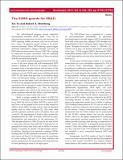| dc.contributor.author | Ye, Xin | |
| dc.contributor.author | Weinberg, Robert A | |
| dc.date.accessioned | 2018-07-13T13:15:31Z | |
| dc.date.available | 2018-07-13T13:15:31Z | |
| dc.date.issued | 2017-11 | |
| dc.date.submitted | 2017-11 | |
| dc.identifier.issn | 1949-2553 | |
| dc.identifier.uri | http://hdl.handle.net/1721.1/116966 | |
| dc.description.abstract | The cell-biological program termed epithelial-mesenchymal transition (EMT) plays a key role in adenocarcinoma progression, invasion, and metastasis. An EMT operating within carcinoma cells can be activated by a variety of paracrine signals arising in the tumor microenvironment. These EMT-inducing signals trigger profound transcription changes through activation of EMT-inducing transcription factors (EMT-TFs), leading to repression of genes associated with the epithelial differentiation program and activation of those associated with the mesenchymal program. | en_US |
| dc.publisher | Impact Journals, LLC | en_US |
| dc.relation.isversionof | http://dx.doi.org/10.18632/ONCOTARGET.22432 | en_US |
| dc.rights | Creative Commons Attribution 3.0 Unported license | en_US |
| dc.rights.uri | http://creativecommons.org/licenses/by/3.0/ | en_US |
| dc.source | Oncotarget | en_US |
| dc.title | The SUMO guards for SNAIL | en_US |
| dc.type | Article | en_US |
| dc.identifier.citation | Ye, Xin, and Robert A. Weinberg. “The SUMO Guards for SNAIL.” Oncotarget 8, no. 58 (November 15, 2017). | en_US |
| dc.contributor.department | Massachusetts Institute of Technology. Department of Biology | en_US |
| dc.contributor.mitauthor | Weinberg, Robert A | |
| dc.relation.journal | Oncotarget | en_US |
| dc.eprint.version | Final published version | en_US |
| dc.type.uri | http://purl.org/eprint/type/JournalArticle | en_US |
| eprint.status | http://purl.org/eprint/status/PeerReviewed | en_US |
| dc.date.updated | 2018-07-12T14:34:51Z | |
| dspace.orderedauthors | Ye, Xin; Weinberg, Robert A. | en_US |
| dspace.embargo.terms | N | en_US |
| dc.identifier.orcid | https://orcid.org/0000-0002-0895-3557 | |
| mit.license | PUBLISHER_CC | en_US |
